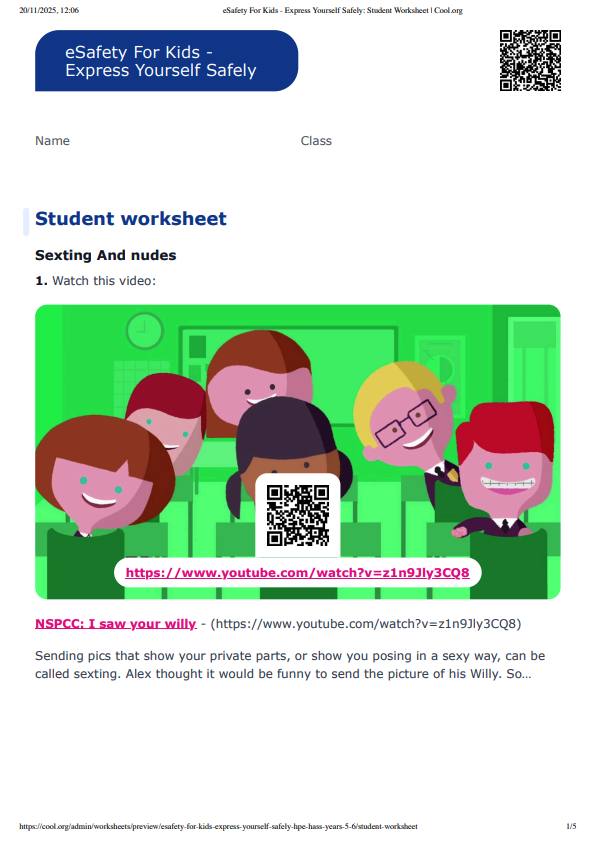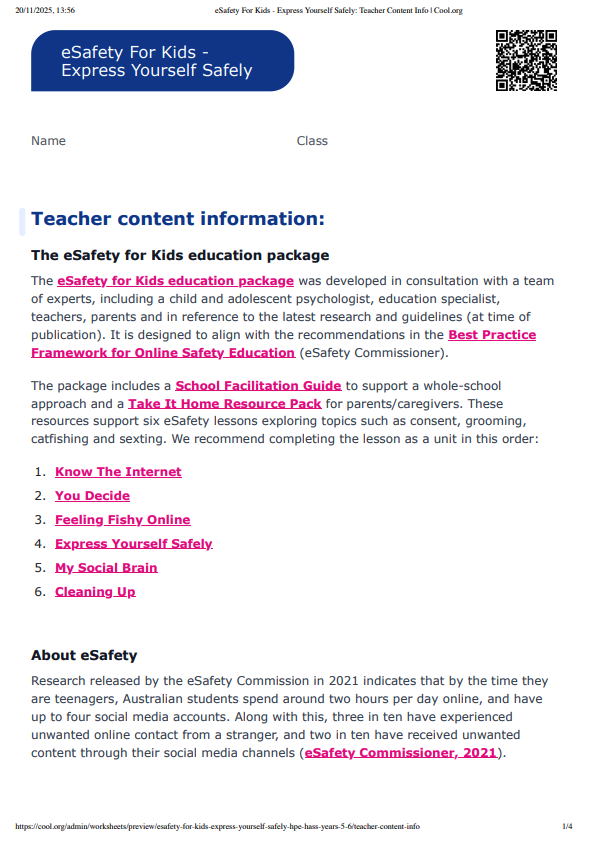Lesson summary
Students will consider the legal ramifications of sharing explicit content – even with consent – and learn how to find support. They will think about fun alternatives for expressing themselves and create resources to encourage others to do the same.
Learning intentions:
Students will:
- understand the laws around sexting for minors (under 18s)
- understand the legal support available
- understand the consequences of sharing intimate images, even with consent.
Success criteria:
Students can:
- explain the laws around sharing sexy images
- identify where to find support if they are in a tricky situation with images they have shared.
Lesson guides and printables
Curriculum links
Select your curriculum from the options below.
Lesson details
Skills
This lesson is designed to build students’ competencies in the following skills:
- communication
- creativity
- digital literacy
- empathy
- social skills
Curriculum Mapping
Australian Curriculum content descriptions:
Years 5 & 6 Health and Physical Education:
- Plan and practise strategies to promote health, safety and wellbeing (ACPPS054)
- Examine the influence of emotional responses on behaviour and relationships (ACPPS056)
Year 5 Humanities and Social Science:
- Why regulations and laws are enforced and the personnel involved (ACHASSK117)
Year 6 Humanities and Social Science:
- Where ideas for new laws can come from and how they become law (ACHASSK146)
Year 5 English:
- Use comprehension strategies to analyse information, integrating and linking ideas from a variety of print and digital sources (ACELY1703)
Year 6 English:
- Use comprehension strategies to interpret and analyse information and ideas, comparing content from a variety of textual sources including media and digital texts (ACELY1713)
Syllabus outcomes: PHS3.12, SLS3.13, COS3.1, INS3.3, IRS3.11, EN3-3A
General capabilities: Literacy, Personal and Social Capability, Ethical Understanding, Information and Communication Technology (ICT) Capability
Relevant parts of Years 5 & 6 HPE achievement standards:
Students recognise the influence of emotions on behaviours and discuss factors that influence how people interact. They describe their own and others’ contributions to health, physical activity, safety and wellbeing.
Relevant parts of Year 5 Civics & Citizenship achievement standards:
Students identify the importance of values and processes to Australia’s democracy and describe the roles of different people in Australia’s legal system. They identify various ways people can participate effectively in groups to achieve shared goals and describe different views on how to respond to a current issue or challenge.
Relevant parts of Year 6 Civics & Citizenship achievement standards:
Students explain the role and importance of people, institutions, and processes to Australia’s democracy and legal system. They describe the rights and responsibilities of Australian citizens and the obligations they may have as global citizens.
Relevant parts of Year 5 English achievement standards:
When reading, students encounter and decode unfamiliar words using phonic, grammatical, semantic and contextual knowledge. They analyse and explain literal and implied information from a variety of texts.
Relevant parts of Year 6 English achievement standards:
Students compare and analyse information in different and complex texts, explaining literal and implied meaning. They select and use evidence from a text to explain their response to it.
This lesson is part of the wider unit of work eSafety For Kids
Time required: 60 mins
Level of teacher scaffolding: Medium – support students to interpret factsheet and summarise
Resources Required
- Art materials of your choice – coloured pencils, felt tip markers or paints
- Device to display videos and websites
- Glossary of Key Terms (optional)
- Handling Sensitive Topics and Issues Factsheet (digital copy)
- Sexting Factsheet
- Student Worksheets – one copy per student
Connected resources:
Additional Info
Although this can be completed as a standalone lesson, it will be most effective if completed within the sequence of the unit, as follows:
The eSafety for Kids education package was developed in consultation with a team of experts, including a child and adolescent psychologist, education specialist, teachers, parents and in reference to the latest research and guidelines (at time of publication). It is designed to align with the recommendations in the Best Practice Framework for Online Safety Education (eSafety Commissioner).
The images for this eSafety for Kids package are sourced from The Tweeting Galah book series and used with permission from Kim Maslin.




Welcome back!
Don't have an account yet?
Log in with:
Create your free Cool.org account.
Many of our resources are free, with an option to upgrade to Cool+ for premium content.
Already have an account?
Sign up with:
By signing up you accept Cool.org's Terms and Conditions(Opens in new tab) and Privacy Policy(Opens in new tab).